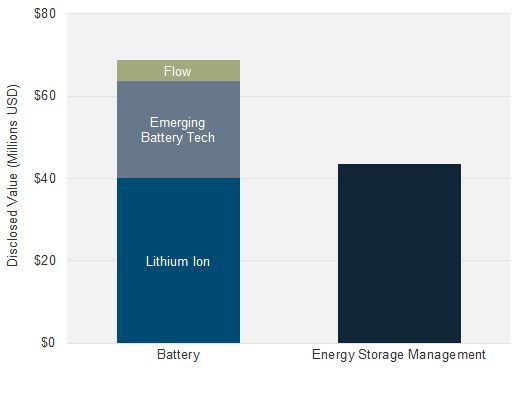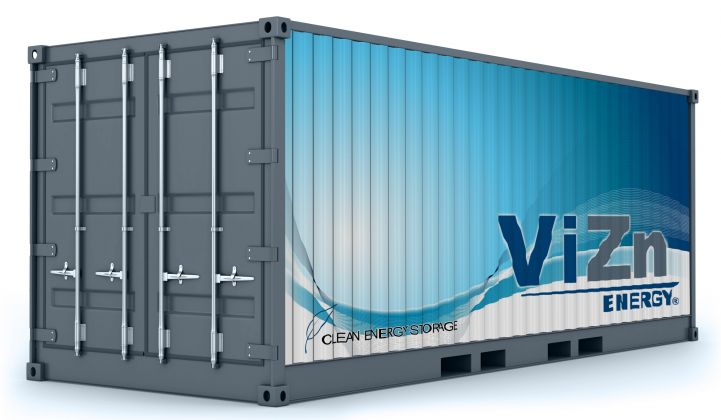Last year, we profiled ViZn Energy Systems, a Montana startup with an unusual alkaline electrolyte-based flow battery technology built to support both multi-hour energy storage and high-power applications, all at a target price point of $400 per kilowatt-hour. That’s a nice combination of capabilities at a nice price -- if it can prove itself in real-world settings.
Since then, ViZn has moved its headquarters to Austin, Texas, signed up customers, brought in new funding, and lined up financing and manufacturing partners to get its Z20 storage units into the field. It’s also staking a new claim in the increasingly competitive price wars for grid-scale batteries, targeting $200 per kilowatt-hour in the next two to three years, CEO Ron Van Dell said in an interview this week.
ViZn only has a little more than 1 megawatt-hour of systems installed to date, including its inaugural deployment with BlueSky Energy for an Austrian microgrid project, a second system for Kalispell, Mont.-based utility Flathead Electric Cooperative, and in April, a system at Randolph-Macon College as part of a solar project for Virginia utility Dominion Resources.
But the startup has “over 20 megawatt-hours contracted to businesses right now, in applications that span commercial industrial, to microgrid, to utility scale, to military,” Van Dell said. While he wouldn’t name any of these new customers, they cover North America, Europe, Africa and Asia, including an off-grid project in Africa, and several projects integrated with on-site solar systems, he said.
ViZn has also brought its finding from about $20 million as of last year to just under $30 million today, he said. “Our funding to date is entirely high-net-worth individuals,” he said. “We’re working right now on what will be our first and last institutional round, which should close this summer.” ViZn is targeting $25 million for that round to fund its business plan through the end of 2016, at which point the company expects to be cash flow break-even, he said.
In March, ViZn announced a financing deal with LFC Capital, to offer 6- to 7-year leases to customers for up to $5 million per project. That’s a tactic being taken up by lots of energy storage providers, including Stem, Coda Energy, and Green Charge Networks, to ease the upfront financial burden for commercial and industrial customers looking for energy storage options. The company expects to announce its first lease deals sometime this summer, he said.
Also this week, ViZn announced that contract manufacturer Jabil Circuit will build its flow batteries for current and future contract commitments. Again, this is a common step for energy storage startups that want to avoid raising capital to build their own manufacturing facilities; Jabil is also building batteries for flow battery startups REDT and Vionx Energy (formerly Premium Power), while Flextronics is working with Imergy, RedFlow and Green Charge Networks, to name a few examples.
Flow batteries, which pump electrolyte through electrochemical cells, tend to be simpler to build than closed-system lithium-ion and lead-acid batteries, which often require clean-room facilities, nanostructured materials and complex manufacturing processes. Flow batteries can also add more tanks of electrolyte to expand their energy capacity to several hours, whereas today’s most advanced lithium-ion grid-scale batteries struggle to provide more than 2 hours of storage at competitive prices.
But the key difference between ViZn’s technology and other flow batteries, Van Dell said, is that “we’re very good at supporting both power and energy applications. We can do multi-hour discharge, we can also do very fast charge and discharge, and we can switch between charge and discharge as fast as the inverter can.”
Flow batteries struggle with achieving high power density, due to the challenge of pumping electrolyte quickly through electrodes and membranes without excessive degradation or exceeding efficient and safe operating parameters.
ViZn licensed that core IP for its systems from Lockheed Martin, which had spent about eight years developing the technology prior to that. Then the company “spent five years, six generations of prototypes, 700 cell designs -- not to mention the various chemistry optimizations along the way -- to get to where we are now,” he said.
The result is a system that can “do a fast charge or discharge for a short period of time and not impact the life of the battery.” Tests have shown that the technology has the ability to achieve three times the system’s nominal peak power rating, he said.
_580_158_80.jpg)
ViZn’s zinc-iron electrolyte is also cheap compared to the core material used in lithium-ion batteries or vanadium redox flow batteries, he said. “Our electrolyte is abundantly available materials that come in bags of dry powder. You ship it dry, you bring up some local soft water, and you mix in our powders at the site,” he said.
Zinc-based flow batteries have had challenges in maintaining performance with repeated use, due to buildup of metals on the electrodes. Reaching ViZn’s claim of 20 years and 10,000 cycles of operating life has required solving “some fundamental challenges with a zinc-based metal liquid system,” he said. “It has to be able to manage the metal coming in and out of the solution as part of your charge and discharge, and that behavior has to be very reproducible, very robust, and still yield high performance. There are things that relate to [issues such as] how to do the zinc morphology, how to manage the fluid mechanics of your design, how to deal with shunt current.”
As for round-trip efficiency -- a measure of the amount of energy coming out of the battery compared to what goes into it -- ViZn is hitting the mid-70 percent range for AC-to-AC efficiency, he said. That’s fairly typical for flow battery systems, but low compared to the nameplate efficiency of lithium-ion batteries. However, Van Dell cautioned that those figures often don’t include the amount of electricity required for cooling and thermal management, which ViZn’s system doesn't require.
Lithium-ion is by far the most commonly deployed grid-scale energy storage technology out there, putting pressure on flow battery contenders to get lots of systems up and running to prove their long-term capabilities. That’s starting to happen. Startup Imergy Power Systems is selling its vanadium redox flow batteries to telco providers, and recently landed a deal to sell 1,000 systems to SunEdison for microgrids in India. UniEnergy, another vanadium flow battery startup, has 3.5 megawatts of systems being deployed in Washington state and California.
At the same time, the flow battery industry has also seen its share of false starts. EnerVault, a startup making flow batteries with iron-chromium electrolyte, announced in April that it was restructuring and seeking new owners after being unable to raise more capital.
GTM Research has tallied about $112 million in investment for energy storage companies so far this year, with ViZn’s funding being one of the smaller slices of that pie. Other battery companies that have raised money this year include Eos Energy Storage, Boston-Power, Sakti3 and ZAF Energy Systems.




